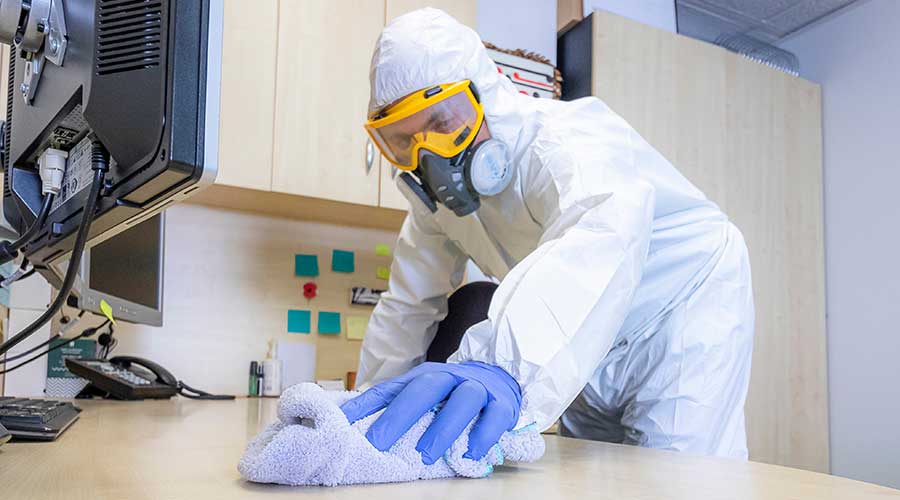Treasure Coast Hospice has reduced HVAC maintenance costs, increased unit efficiencies and extended equipment lifecycles while simultaneously increasing patients' indoor air quality (IAQ) with the installation of ultraviolet germicidal irradiation (UVGI) light systems on all air conditioning equipment.
TCH, which operates two identical 15,000-square-foot, 16-room hospice facilities in Stuart and Ft. Pierce, Fla., conducted a 90-day UV trial on one packaged terminal air conditioner (PTAC) with unprecedented coil dirt build-up and found an installed UVGI lamp significantly reduced the dirt and mold growth.
The successful demonstration led to a two-year program of installing UVGI systems on 32 patient room PTACs and 16 split systems servicing common areas and offices at both locations, according to Pence an EPA-certified and Florida licensed contractor who has used UV on other clients' air conditioning coils since 2000.
"We like the concept of UV lamps on our HVAC coils," said James Smith, director of facilities, Treasure Coast Hospice, which is one of Florida's top 10-rated hospices. "We estimate the UV program is saving us a great deal in maintenance costs and cleaning materials."
All air conditioning coils can potentially develop mold growth, because they are inherently dark places with high moisture from condensation--two essentials for microbial development. Therefore, Pence still performs an annual pull-and-clean on the facilities' 32 total PTACs, which serve individual 328-square-foot hospice rooms, but cleaning time has been reduced from two hours to a 1/2-hour per unit. Each PTAC is now equipped with a Tight-Fit Kit UV light system, designed specifically for the cramped confines of PTACs and fan coils by UVGI system manufacturer www.freshaireuv.com Fresh-Aire UV.
Each UV system installation required a 30 to 40-minute installation requiring pulling the PTAC out of the wall, connecting to the PTAC power supply inline before the controls for 24/7 operation, and attaching the magnetic lamp base to an interior metal encasement wall. The UV-C lamps are warranted for two years continuous operation and the rest of the kit carries a lifetime warranty. None have failed, according to Pence.
The two facilities also have a total of eight American Standard split- system HVAC units. The Commercial Series Tubular Rack UV System with UV lamps on the coils and AHU Series 1 UV lamps were installed in selected fan compartments, both of which are also manufactured by Fresh-Aire UV. The coil UV lamp kits are designed for quick 30-minute installations using common and inexpensive electrical EMT conduit as a support structure. The fan compartment kits include dual 32-inch-long lamps and optional shields to protect fan belts and other rubber or plastic components against premature deterioration from UV exposure.
One air conditioning system serving a large meeting room was outfitted with an APCO combination UV light and activated carbon air purifier that eliminates unpleasant odors as well as biological contaminants. The system uses titanium oxide-infused carbon-based media that adsorbs gaseous contaminant odors and photo catalytic oxidation (PCO) methodology to regenerate the media.
UVGI is a fast-growing technology used to keep coils and interior HVAC systems free of dirt and maintenance-intensive mold accumulations. Keeping coils clean longer also adds to unit efficiencies. For example, a thin growth of bio-film on coil surfaces has been proven in lab tests to reduce the free area of heat transfer and increase air velocity up to nine percent. Cleaner coils can also deliver an impressive 30 percent or more increase in cooling capacity when compared to dirty coils. Ultimately, cleaner coils require smaller quantities of cleaning chemicals, which helps preserve the environment.
UVGI also improves IAQ by killing potential respiratory-infecting airborne biological contaminants as they pass through the PTAC coil's UV field. In an era where hospital acquired infections (HAI) have become a major concern in the healthcare industry, TCH residents can be assured that any potential airborne bacteria, viruses or mold spores are less likely spread by the HVAC system.
Another benefit is extended equipment lifecycles. Doug Pence, president of HVAC service contractor Absolutely Cool Air LLC, who has serviced TCH's air conditioning equipment for the past eight years, said that because the UV lamps are maintaining cleaner coils, there's less corrosion and subsequently fewer premature failures. The 1.5-ton PTACs by Friedrich Air Conditioning and newer replacement units by Gree are now performing beyond the lifecycles of previous PTACs prior to UV installations.
"We're extending the lifecycles of the PTACs because compressors have less wear from the efficiency benefits of cleaner coils, and the coils themselves don't prematurely corrode and therefore are subject to less refrigerant leaks," said Pence.
Reducing leaks by eliminating biological corrosion is also saving thousands of dollars annually because Pence typically spends two to four hours either repairing a leaking coil by conventional methods or via leak sealants. Post-leak refrigerant replacement is costly. Refrigerant prices have skyrocketed since the enactment of an EPA-mandated manufacturing ban on ozone-depleting hydrochorofluorocarbon (HCFC) chemicals, such as the R-22 used in TCH's older PTACs and split-system air conditioning units.
Although the UV installation program is saving operating costs, the bottom line is TCH patients get odor-free IAQ amid an environment with fewer potentially harmful biological contaminants.

 Bugs Without Borders: The Coming HAI Crisis
Bugs Without Borders: The Coming HAI Crisis Deadly Patient Assault Breaks Out at Fulton State Hospital
Deadly Patient Assault Breaks Out at Fulton State Hospital County of Santa Clara to Acquire Regional Medical Center from HCA Healthcare
County of Santa Clara to Acquire Regional Medical Center from HCA Healthcare Designing Senior Care Facilities with Veterans in Mind
Designing Senior Care Facilities with Veterans in Mind All Children's Specialty Physicians Outpatient Care Opens in Wesley Chapel Area
All Children's Specialty Physicians Outpatient Care Opens in Wesley Chapel Area